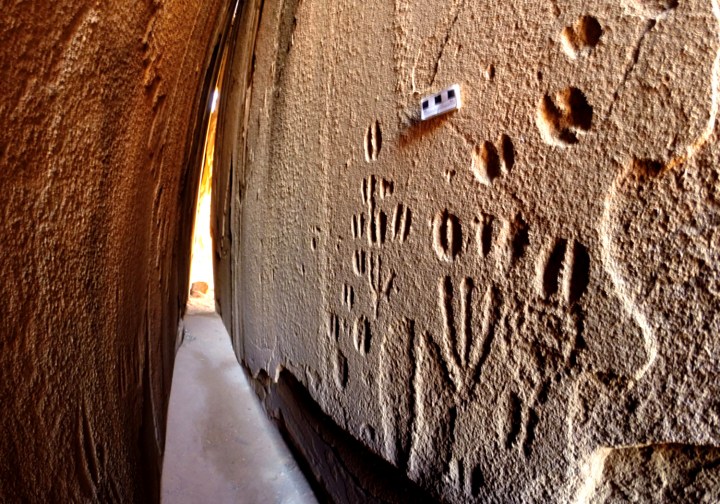FORGOTTEN FOOTPRINTS
San trackers guide archaeologists in unlocking secrets of ancient human spoor and rock art in Namibia

In a first, the trackers were able to not only identify different species but also the sex of the animals and humans the engravings were meant to depict.
Across rock panels in the Doro! Nawas Mountains in central Western Namibia three San trackers were tasked with following spoor that cut across rock.
The men from the Nyae Nyae Conservancy in Tsumkwe, Namibia usually use their skills tracking game for hunters or tourists, but this was something totally different. The tracks here were human-made and engraved into the rock face. On six rock panels are images of animals, humans and trackways of spoor all left by Stone Age hunter-gatherers who painstakingly etched each print into the rock.
Until Tsamgao Ciqae, Ui Kxunta and Thui Thao cast their eyes on the pictographs archaeologists had spent little time studying these footprints that had been cast in stone.
The surprise was that the trackers were able to not only identify different species from these prints, but also the sex of the animals and humans these engravings were meant to depict.
The research, which was published on 13 September in the open-access journal Plos One, is the latest study where San trackers have teamed up with archaeologists and used their tracking skills to interpret the past.
Previously the team of trackers worked in France and Spain where they studied ancient human footprints that were left in a series of caves tens of thousands of thousands of years ago. They were able to deduce not only the ages and the sex of the earlier humans that left the prints but could also tell archaeologists what the owners of the prints may have been doing inside those caves.
What the three trackers discovered when they examined the Doro! Nawas mountain pictographs was that a great deal of care had been put into carving the prints — so much so that they were able to identify 90% of the 513 engravings.

Using their tracking skills, the three San trackers were able to identify the different spoor and also the sex of the animals and humans depicted in the engravings. (Photo: Peter Breunig)
The animal spoor identified included bushpig, buffalo, monkey and caracal as well as various antelope. There were even bird tracks which the trackers identified as belonging to red-crested korhaan and marabou.
“Researchers have until now completely neglected the fact that traces and tracks are also a valuable source of information,” explains PD Dr Andreas Pastoors, from Friedrich-Alexander-University of Erlangen-Nürnberg, in Germany, in a statement. Pastoors was the lead author in the study.
Read more in Daily Maverick: Rock art rocks: Experts are still trying to fathom ancient engravings found near the Vredefort crater
The trackers were also able to note another interesting detail about some of the spoor. The tracks “moved” in certain directions.
“We beamed a virtual clock onto the rock face and then noted the direction of the tracks according to the hours on the clock face.”
The result: Most tracks pointed upwards towards 12 o’clock and only a few pointed down towards 6 o’clock. The one exception was the zebra tracks, which were depicted travelling in all directions.
“It’s really exciting to see that the animal tracks can give us far more information than we originally thought,” says Pastoors.
Another surprise is that some of the animal species depicted in the rock art are not found in this part of Namibia, as they require wetter habitats. The researchers believe that either conditions were wetter then, or that the artists had travelled to other regions and had seen those animals there.
But the mystery is just why these hunter-gathers went to such great lengths to so accurately recreate the spoor.

The rock panels also depict animals. (Photo: Peter Breunig)
The San suggested that perhaps the images were “teaching aids” to help younger wannabe trackers identify spoor correctly.
The problem with this hypothesis, the researchers point out in the paper, is that some of the sites are hard to access.
Another theory is that they were used for shamanistic rituals.
The late rock art researcher and author Ed Eastwood suggested that engraved spoor might have been used by hunters in a ceremony to gain power over the animal they were about to track.
Accounts of San hunting practices tell of hunters striking the spoor of the animal they were about to track with a spear.
Eastwood had studied similar engraved prints that were found in the Limpopo valley, in South Africa.
But finding the answer as to why those hunter-gathers did this all that time ago is going to be difficult.
“We don’t know the meaning of any Stone Age rock art in the world because we don’t have the Rosetta Stone,” says Pastoors. “Our study has shown how much information is hidden in the depiction of human tracks and footprints, and that we can capture it with the right knowledge. In the future, it will be difficult not to involve track experts in the study of Stone Age tracks.” DM

















 Become an Insider
Become an Insider
Comments - Please login in order to comment.